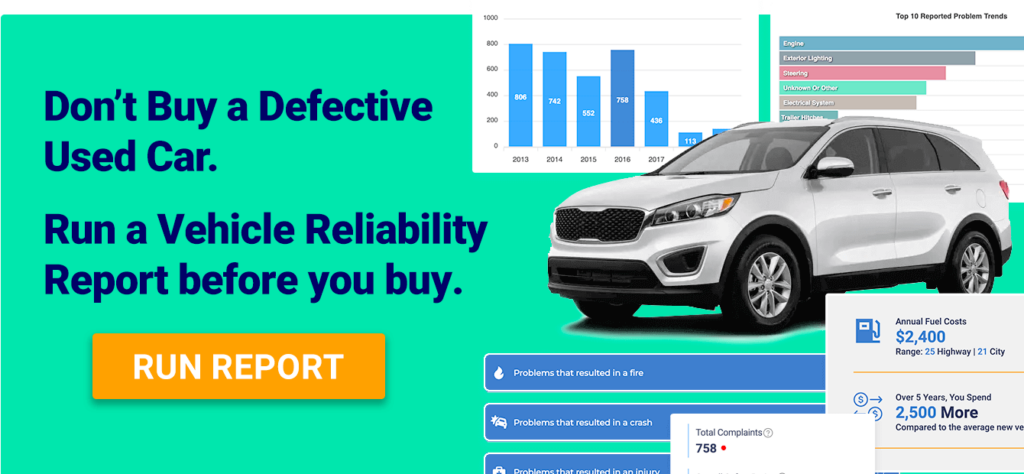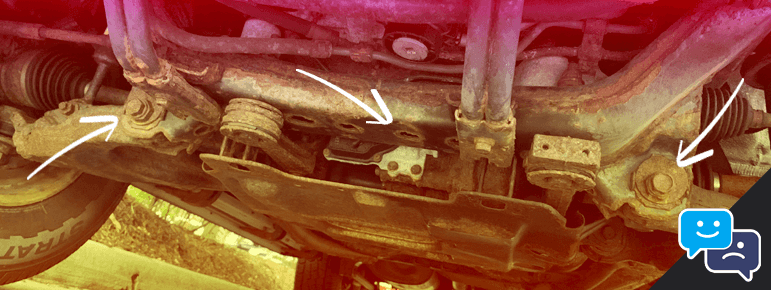Last Updated on August 17, 2023
Ever caught a glimpse of an orange-brown patch on your car’s frame, and wondered how much frame rust is too much? Rusting is a common but potentially dangerous issue that can wreak havoc on your vehicle if left unchecked.
Truth is, if the rust is just cosmetic and hasn’t compromised the vehicle’s structural integrity, it’s typically safe to overlook. However, if the rust has significantly degraded the metal’s strength, immediate action is necessary.
Undoubtedly, encountering rust on vehicle components is not rare. However, extensive rust that jeopardizes the vehicle’s integrity is a significant concern. Because it poses safety risks to both the driver and passengers.
This article will guide you in understanding frame rust, identifying its severity, and exploring repair options or preventative measures. Get ready for some practical advice that could save your ride from becoming a heap of oxidized metal!
Understanding Frame Rust
Frame rust refers to the corrosion and deterioration of a vehicle’s frame due to exposure to moisture, salt, and other elements.
What is Frame Rust?
Frame rust is corrosion that forms on the car’s frame. It happens when iron, air and water come together. This mix can lead to metal degradation over time.
Surface rust and deep or structural rust are the two types of frame rust. Surface rust only affects the top layer of your car’s frame. Structural rust goes deeper and makes holes in the metal parts it hits.
In fact, Toyota says a 10mm hole from this kind of rust makes a car unsafe.
Why is Frame Rust Bad For Your Car?
Frame rust can harm your car in many ways. It is a sign of corrosion or oxidation on the metal parts of your car. This happens when air and water mix on bare metal.
One big problem with frame rust is safety risks. The frame of a car gives it strength. Rust can make the frame weak. If not treated, holes may form in the frame over time. Driving a rusty car can be risky.
Another bad part about rust is how it looks. People like their cars to look good! Rust spots do not look good at all! Plus, if you want to sell your car, rust will bring down its price.
Lastly, rust messes up how your car works too! For instance, if there’s rust on wheel parts or brake parts, they may not work right anymore.
Different Types of Frame Rust
There are two types of frame rust. These are surface rust and structural rust. Surface rust is what you can see on the top layer of your car’s body. It looks like light brown or faint red spots on the metal parts.
Even though it may not look good, this type of rust does not hurt your car’s health.
On the other hand, structural rust is a bigger problem for cars. This kind of rust eats away at important parts under your car like its frame and underbody. It can change the strength of these parts over time, which could put you in real danger if these pieces were to break while driving.
Once surface rust starts to eat into deeper layers, it becomes structural rust. We must keep an eye out for both types since they damage our vehicle differently but surely cause harm sooner or later.
Signs of Excessive Frame Rust
Excessive frame rust can be identified by visible holes in the frame due to rust, a hollow sound when tapping on the frame, and flaking rust on the surface.
How to Tell if Frame Rust is Too Much
Excessive frame rust can be a big problem for your car. But how do you know if the rust is too much? There are some signs you can look out for. One way to tell is by checking the fender wells.
If they have a lot of rust, it could mean that there is more on the frame as well. Another sign is if you notice any holes or deep corrosion on the frame. This can indicate that the metal has been weakened and may compromise the structure of your vehicle.
It’s important to pay attention to these signs because excessive corrosion can affect your car’s safety and performance.
When Should You Worry about Frame Rust?
You should worry about frame rust when considering the age and condition of your vehicle, its location and severity, and how it impacts safety and performance.
Consideration of The Vehicle’s Age and Condition
The age and condition of a vehicle are important factors to consider when determining how much rust is too much. Older vehicles tend to be more prone to rust due to wear and tear over time.
If a car is already in poor condition or has high mileage, it may not be worth investing in repairs for excessive frame rust. It’s also important to think about the price of the vehicle relative to its condition.
If the cost of fixing the rust exceeds the value of the car, it might be better to look for another option. Ultimately, considering the age and condition of a vehicle helps determine whether dealing with frame rust is worth it or if it’s time to move on.
Location and severity of rust
The location and severity of rust on a car frame are important factors to consider when determining if it is too much. Rust can occur in various areas of the vehicle, including the undercarriage, wheel wells, and joints.
The severity of rust can range from surface rust, which appears as small patches or discoloration, to deep rust that causes flaking or deterioration of the metal.
When assessing the severity of rust, it’s crucial to look for signs of structural weakness. Deep rust indicates more severe corrosion compared to surface rust and can compromise the integrity of the frame.
If there are holes or significant material loss due to flaking rust, it may be an indication that the frame has been extensively damaged by corrosion.
Regular inspections are essential in identifying any developing areas of concern early on. It’s also important to note that driving conditions and exposure to moisture and salt can accelerate rust formation.
Impact on safety and performance
Excessive frame rust can have a significant impact on the safety and performance of a vehicle. When rust eats away at the metal, it causes corrosion, oxidation, and deterioration. This weakens the frame and compromises its structural integrity.
As a result, the car becomes more vulnerable to accidents and failures on the road.
Rust not only affects safety but also impacts performance. The weakened frame can lead to handling issues, instability, and overall degradation of the vehicle’s capabilities. It can affect how well the car responds to steering inputs and how stable it remains during acceleration or braking.
Can Rusty Frames Be Repaired?
Options for repairing rusty frames include sanding and repainting, using rust converters or inhibitors, welding patches or plates onto the affected areas, and in severe cases, replacing the entire frame.
Options for repairing rusty frames
There are a few options available for repairing rusty frames in cars, SUVs, and trucks. One option is to use replacement parts and reinforcement plates specifically designed for fixing rusted frames.
These parts can be purchased from companies that specialize in frame repair services. Another option is frame restoration, which involves removing the rust and applying protective coatings or treatments to prevent further corrosion.
In some cases, frame welding repairs may be necessary to restore the structural integrity of the frame. It’s important to consider factors such as the severity of rust damage and the cost of repairs when deciding on the best option for your vehicle.
Factors to consider in determining repairability
When determining the repairability of a rusty frame, there are several factors to consider. One important factor is the extent of the rust damage. If the rust has spread extensively and compromised the structural integrity of the frame, it may be difficult or even impossible to repair.
The cost of repairing a rusted frame is another crucial factor. Depending on the severity of the damage, repairs can range from $1,500 to over $10,000. It’s essential to weigh these repair costs against the value of your vehicle.
If your car is older or has low value, spending a significant amount on repairs may not be worth it.
Another consideration in determining repairability is whether there are alternative options available for addressing frame corrosion. In some cases, using protective coatings or treatments can help slow down further rusting and extend the lifespan of your frame without costly repairs.
Preventing Frame Rust
To prevent frame rust, regularly inspect the undercarriage for any signs of rust and address them promptly. Apply protective coatings or treatments to the frame to create a barrier against moisture and corrosion.
Tips for preventing frame rust
To prevent frame rust on your vehicle, there are a few important tips to keep in mind. Firstly, regularly wash your car and make sure to clean the undercarriage thoroughly. Removing dirt and debris can help prevent moisture from accumulating and causing rust.
Additionally, applying protective coatings or treatments specifically designed for preventing rust can provide an extra layer of defense against corrosion.
Another important tip is to perform regular inspections and maintenance on your vehicle. This allows you to identify any signs of rust early on and address them before they become more severe.
Stay vigilant and check for any areas where paint may be chipped or scratched, as these are vulnerable spots where rust can start.
Lastly, consider waxing your car regularly as part of your routine maintenance. Wax acts as a barrier between the metal surface of the vehicle and moisture in the air, helping to prevent oxidation that leads to rust formation.
Regular inspections and maintenance
Regular inspections and maintenance are crucial in preventing frame rust from becoming a serious problem. By regularly inspecting your car for any signs of rust, you can catch it early on before it spreads and causes structural damage.
This is especially important if you live in an area with harsh weather conditions or salted roads, as these factors can accelerate the development of rust.
When performing inspections, pay close attention to areas that are prone to rust, such as the undercarriage, wheel wells, and around the edges of doors and windows. If you notice any surface rust or bubbling paint, it’s essential to take action immediately.
Regularly washing your car can also help remove dirt and debris that could contribute to rust formation.
In addition to inspections, maintaining your car’s paintwork is essential for preventing rust. A well-maintained coat of wax or sealant acts as a protective barrier against moisture and corrosive substances.
Protective coatings and treatments
Protective coatings and treatments are essential for preventing frame rust. Rustproofing is the best way to defend your car against corrosive contaminants that can’t be easily washed off.
Applying a protective coating at least once per year is recommended for optimal rust prevention. While coatings can help prevent surface rust, it’s important to note that internal frame rot is a bigger concern for vehicles.
Certain models, like the 2014 Chevy Silverado with its GM wax-coated frame, are designed specifically to resist rust. However, it’s crucial to avoid undercoating with hard paint or rubberized wax as this can trap moisture and allow oxidation to continue.

Final Thoughts
Simply put, determining how much frame rust is too much depends on various factors. The age and condition of the vehicle, the severity and location of the rust, as well as its impact on safety and performance all play a role.
Regularly inspect and maintain your vehicle to prevent excessive rust and address it promptly if it occurs. Remember, excessive frame rust can pose a safety hazard, so it’s important to take action when needed.
If you ever have any doubts, get the vehicle looked over by a trusted mechanic.

Managing Editor
Christopher is an automotive technical writer. When he’s not at the local autocross event, he can often be found working on one of his cars. Specializes in automotive class action law, industry trends, and automotive maintenance. Email me direct, or learn more about us


Gerry W.
August 18, 2023 at 1:38 pmI had a 2011 FJ CRUISER Trail Team Edition. I purchased new along with the rust proofing. The mounts that hold the body to the rear axle rusted through and snapped, causing the body to move side to side. I never had this vehicle off road. I am a mature 70 year old driver. The vehicle was definitely not safe to drive! I had it towed to the dealer where I purchased it. They told me that the rust through warranty only covered the body. It cost me $2800 to have the rear axle housing replaced. I had 98k miles on the vehicle.